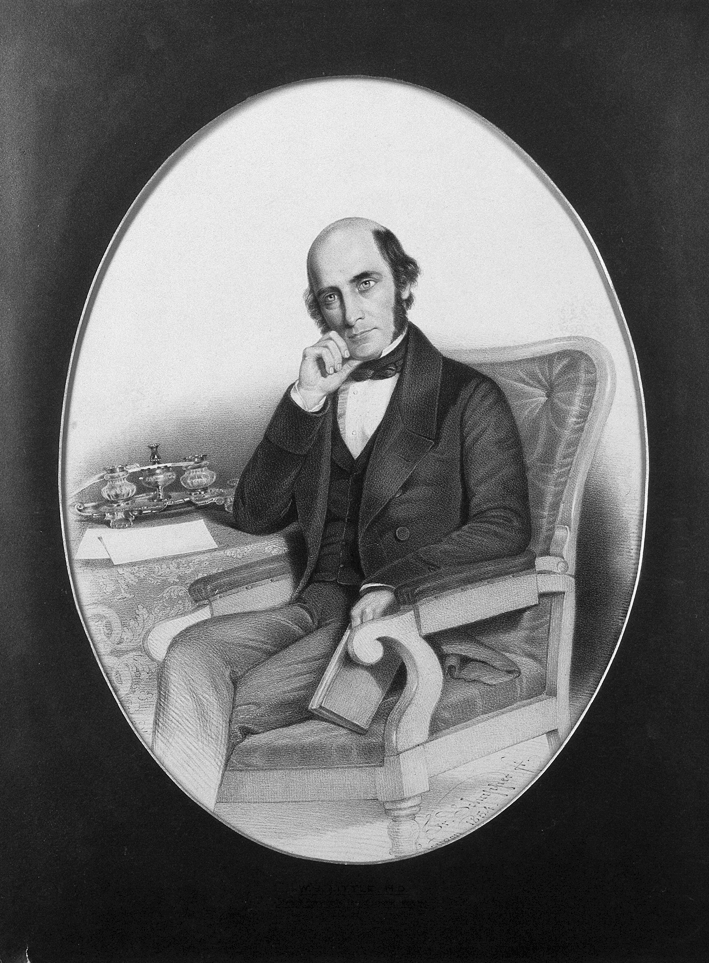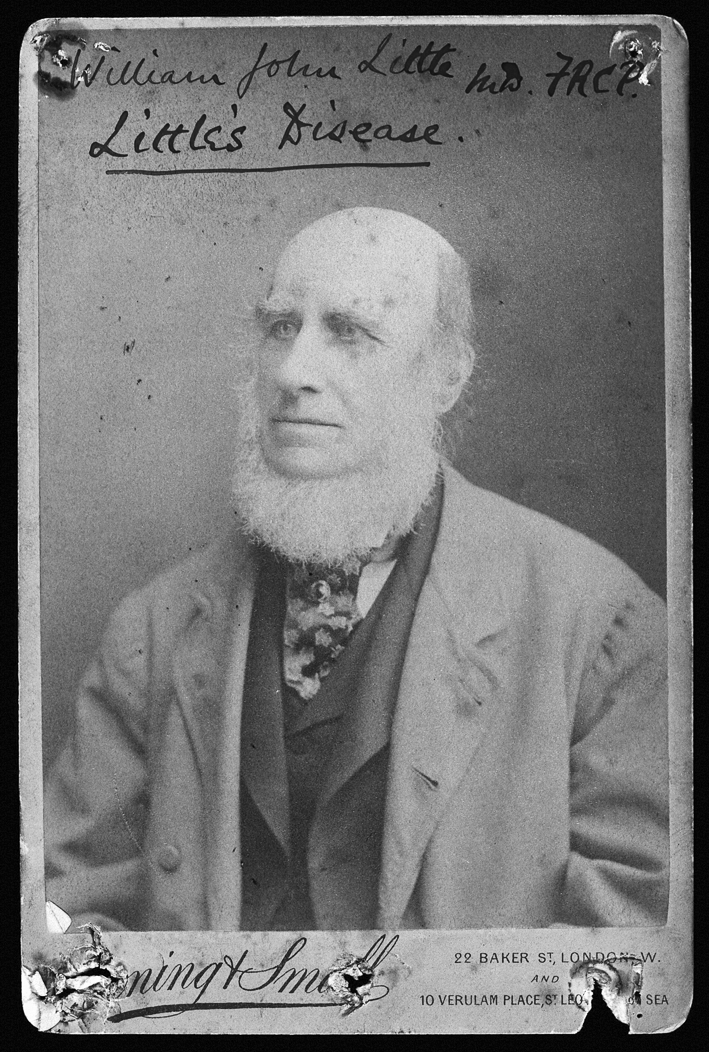Abstract
This biographical sketch on William Little corresponds to the historic text, The Classic: Hospital for the Cure of Deformities: Course of Lectures on the Deformities of the Human Frame (1843), available at DOI 10.1007/s11999-012-2302-y.
Keywords: Medicine & Public Health; Conservative Orthopedics; Orthopedics; Sports Medicine; Surgery; Surgical Orthopedics; Medicine/Public Health, general
William John Little was born in East London in 1810, the third child of John Little, the proprietor of The Red Lion, a rather famous Aldgate inn [1, 5, 6]. He was a sickly child prone to illnesses and, according to Schleichkorn [6], “the family physician…suggested the child be removed from ‘the busy neighborhood of his birthplace to the purer air of a more rural district’.” His parents, in fact, moved him into the country. Little had a clubfoot, although it is unclear when this developed and whether it was congenital or acquired [6]. According to one writer [5], he had been struck with infantile paralysis, which left him with partial paralysis of the left leg and severe contractures with talipes equinovarus. He excelled in school, first in England then France, gaining a prize for French composition in competition with native French speakers at age 16. He returned to England and became apprenticed to an apothecary, but entered medical studies at the London Hospital two years later. Subsequent to qualifying in 1831, he studied at Guy’s Hospital [1] and was appointed as an instructor in anatomy, physiology, and pathology at the London Hospital. However, having made an unsuccessful application for a surgical post at the London Hospital, he moved to Berlin to gain additional qualifications. During that time, he visited Louis Stromeyer of Hannover, who had developed the subcutaneous Achilles tenotomy to correct equinus deformities. Stromeyer performed the operation on Little with apparent success. Little returned to Berlin, impressed his mentors, and completed a thesis, “Symbolae ad Talipedem Varum Cognescendum,” for which he obtained a Doctor of Medicine degree from the University of Berlin [6]. Upon returning to England, Little entered a practice on Finsbury Square, gained experience with the tenotomy, and in 1839 published his now classic monograph, “A Treatise on the Nature of Club-foot and Analogous Distortions; Including Their Treatment Both With and Without Surgical Operation” [2]. His experience and growing fame afforded him a surgical post at the London Hospital, but he also opened the Orthopaedic Infirmary in a mansion on Bloomsbury Square in 1840, the first free-standing hospital devoted to musculoskeletal problems of the limbs and spine. Five years later, he obtained a Royal Charter of Incorporation, and the hospital was renamed, “The Royal Orthopaedic Hospital.” (This hospital, along with the City Orthopedic Hospital, founded in 1851, and the National Orthopedic Hospital in Great Portland Street, founded in 1865, were amalgamated in 1905 with a new Royal Charter under the name, “Royal National Orthopedic Hospital [5].) After an illustrious career, Little retired in 1884, to Ryarsh, near West Kent [5]. He died after a short illness at the age of 84 in 1894.
Fig. 1.

William John Little, FRCS, is shown circa 1854. (Image reproduced with permission from the Wellcome Library, London.)
Fig. 2.

William John Little, FRCS, is shown later in life. (Image reproduced with permission from the Wellcome Library, London.)
Little wrote extensively, publishing a number of books on diverse topics, including clubfoot [2] and genu valgum [4], and many articles. Lancet published a number of his lectures, including the one we reproduce in this issue, “Hospital for the Cure of Deformities: Course of Lectures on the Deformities of the Human Frame,” in which he described spastic deformities [3]. This description led to the appellation, “Little’s Disease,” for what we now know as cerebral palsy. Little described a variety of lower and upper extremity contractures associated with spasticity, recognizing the role of the central nervous system in some of these patients, “It will, however, in many cases (of ‘universal spastic rigidity’) be evidence that the primary cause in the nervous system has subsided.” He continued,
“It is necessary that I should impress upon your attention the mode of original of these cases of deformity, as errors of diagnosis are, in this respect, not uncommon. In adults, the attack can usually be traced to an epileptic, hysterical, or chorea-like seizure; in children the deformity succeeds to an attack of convulsions, but more commonly the origin is unperceived. It is often stated by the parent to have been an injury sustained whilst at play, whereas inquiry elicits the fact that the deformity had not for its cause an origin of that nature, but arose from disturbance of the nervous system.”
Years later, at a meeting of the Obstetrical Society of London in 1861, Little commented [6]:
“Nearly twenty years ago, in a course of lectures published in the Lancet and more fully in a Treatise on Deformities, published in 1843, I showed that premature birth, difficult labours, mechanical injuries during parturition to head and neck, where life had been saved, convulsions following the act of birth, were apt to be succeeded by a determinate affection of the limbs of the child, which I designated spastic rigidity of the limbs of new-born children, spastic rigidity nascentium and the universal spastic rigidity sometimes produced at later periods of existence.”
While Little advocated sectioning of the tendons to correct deformities, he recognized the limitations of the procedure to restore function: “Operative orthopaedy is capable of restoring a contracted useless leg, and fitting it for the ordinary purpose to which, in the civilized state of society, it is applied, but cannot adapt it to the extraordinary use made of it by the athletes or the professional dancer.” He concluded, “…so much the greater therefore must be the reward of him who, by adding to the common stock of knowledge…can so largely contribute to the welfare of his fellow-creatures.” Little made many contributions to our understanding of musculoskeletal diseases and their treatment, and recognized the importance of specialized hospitals for treating musculoskeletal diseases.
References
- 1.Beighton P, Beighton G. The Person Behind the Syndrome. London: Springer-Verlag London Limited; 1997. [Google Scholar]
- 2.Little WJ. A Treatise on the Nature of Club-foot and Analogous Distortions; Including Their Treatment Both With and Without Surgical Operation. London: W. Jeffs; 1839. [PMC free article] [PubMed] [Google Scholar]
- 3.Little WJ. Hospital for the Cure of Deformities: course of lectures on the deformities of the human frame. Lancet. 1843;41:350–354. doi: 10.1016/S0140-6736(02)75213-6. [DOI] [PMC free article] [PubMed] [Google Scholar]
- 4.Little WJ. Medical and Surgical Aspects of In-Knee (Genu Valgum): Its Relation to Rickets, Its Prevention and Its Treatment With and Without Surgical Operation. London: Longmans, Green & Co; 1882. [Google Scholar]
- 5.Mostofi SB, editor. Who’s Who in Orthopedics. Heidelberg, Germany: Springer-Verlag; 2005. [Google Scholar]
- 6.Schleichkorn J. The Sometime Physician”: William John Little - Pioneer in Treatment of Cerebral Palsy and Orthopaedic Surgery. Farmingdale, NY: Jay Schleichkorn, PhD; 1987. [Google Scholar]


